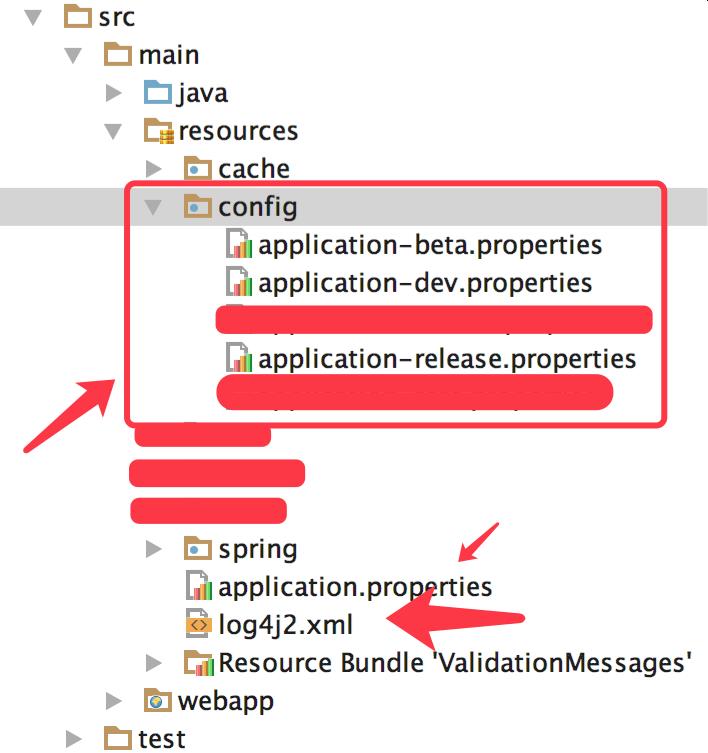maven profile动态选择配置文件
Posted
tags:
篇首语:本文由小常识网(cha138.com)小编为大家整理,主要介绍了maven profile动态选择配置文件相关的知识,希望对你有一定的参考价值。
一、背景
在开发过程中,我们的软件会面对不同的运行环境,比如开发环境、测试环境、生产环境,而我们的软件在不同的环境中,有的配置可能会不一样,比如数据源配置、日志文件配置、以及一些软件运行过程中的基本配置,那每次我们将软件部署到不同的环境时,都需要修改相应的配置文件,这样来回修改,很容易出错,而且浪费劳动力。
maven提供了一种方便的解决这种问题的方案,就是profile功能。
二、profile简介
profile可以让我们定义一系列的配置信息,然后指定其激活条件。这样我们就可以定义多个profile,然后每个profile对应不同的激活条件和配置信息,从而达到不同环境使用不同配置信息的效果。
profile定义的位置
(1) 针对于特定项目的profile配置我们可以定义在该项目的pom.xml中。(下面举例是这种方式)
(2) 针对于特定用户的profile配置,我们可以在用户的settings.xml文件中定义profile。该文件在用户家目录下的“.m2”目录下。
(3) 全局的profile配置。全局的profile是定义在Maven安装目录下的“conf/settings.xml”文件中的。
三、配置动态打包
1、配置profile
在项目的profile中添加如下的profile配置:
<profiles> <profile> <!-- 本地开发环境 --> <id>dev</id> <properties> <profiles.active>dev</profiles.active> </properties> <activation> <!-- 设置默认激活这个配置 --> <activeByDefault>true</activeByDefault> </activation> </profile> <profile> <!-- 发布环境 --> <id>release</id> <properties> <profiles.active>release</profiles.active> </properties> </profile> <profile> <!-- 测试环境 --> <id>beta</id> <properties> <profiles.active>beta</profiles.active> </properties> </profile> </profiles>
这里定义了三个环境,分别是dev(开发环境)、beta(测试环境)、release(发布环境),其中开发环境是默认激活的(activeByDefault为true),这样如果在不指定profile时默认是开发环境,也在package的时候显示指定你要选择哪个开发环境,详情见后面。
2、配置文件
针对不同的环境,我们定义了不同的配置文件,文件目录如下:

如图所示,开发环境、测试环境、生产环境的配置文件分别放到src/main/resources目录下的config文件夹下。
config下有多个环境的配置文件,命名规则为是application-环境名称.properties。
处理过程:
1)通过profile选中你要使用的环境
2)通过package命令,将环境变量注入到application.properties中(这样子,那些公用的环境变量就不用在各个环境的配置文件中配置了)
3)项目中加载application.xml文件
加载配置文件
<context:property-placeholder location="classpath:application.properties"/>
例子:
application-beta.properties文件有如下部分内容:
env.datasource.jdbcUrl=jdbc:mysql://localhost:3306/test?useUnicode=true&characterEncoding=UTF-8&rewriteBatchedStatements=true&autoReconnect=true&zeroDateTimeBehavior=round env.datasource.username=root env.datasource.password=12233
application.properties有部分如下内容用于注入上面的内容:
datasource.jdbcUrl=${env.datasource.jdbcUrl}
datasource.username=${env.datasource.username}
datasource.password=${env.datasource.password}
3、maven资源插件配置
在pom.xml的build结点下,配置资源文件的位置,如下所示:
<build> <finalName>seewo-admin</finalName> <!-- 定义了变量配置文件的地址 --> <filters> <filter>src/main/resources/config/application-${env}.properties</filter> </filters> <resources> <resource> <directory>src/main/resources</directory> <filtering>true</filtering> </resource> </resources> <plugins> <plugin> <groupId>org.apache.maven.plugins</groupId> <artifactId>maven-war-plugin</artifactId> </plugin> </plugins> </build>
这里注意一个参数<filtering>true</filtering>,一定要设置成true.这样才会用对应env目录下的配置文件覆盖原来的。
4、激活profile
1)默认的激活
上面的profile配置中设置的默认的激活环境。如下面所示
<activeByDefault>true</activeByDefault>
2)使用-P参数显示激活一个profile
当我们在进行Maven操作时就可以使用-P参数显示的指定当前激活的是哪一个profile了。比如我们需要在对项目进行打包的时候使用id为dev的profile,我们就可以这样做:
mvn package –Pdev
这里假设dev是在settings.xml中使用dev标记的处于激活状态的profile,那么当我们使用“-P !profile”的时候就表示在当前操作中该profile将不处于激活状态。
5、调用
private Logger logger = LogManager.getLogger(MyApp.class.getName());
其他的使用和log4j的是一样的。
四、遇到的坑
在application.xml文件中不能出现@关键字,就算你注释了也不行。当出现@了,之后的所有环境变量将不会被注入
如:

致谢:感谢您的阅读!
以上是关于maven profile动态选择配置文件的主要内容,如果未能解决你的问题,请参考以下文章
Spring boot项目分环境Maven打包,动态配置文件,动态配置项目